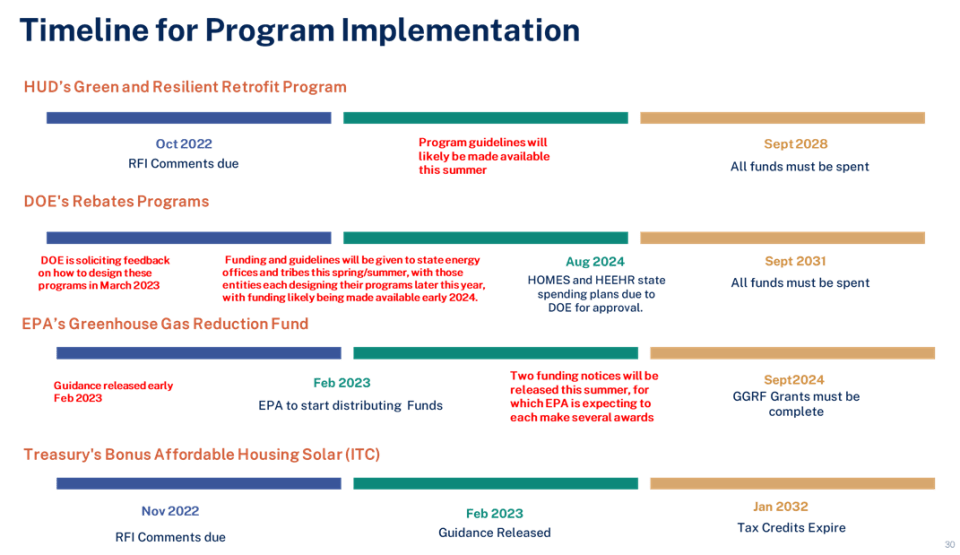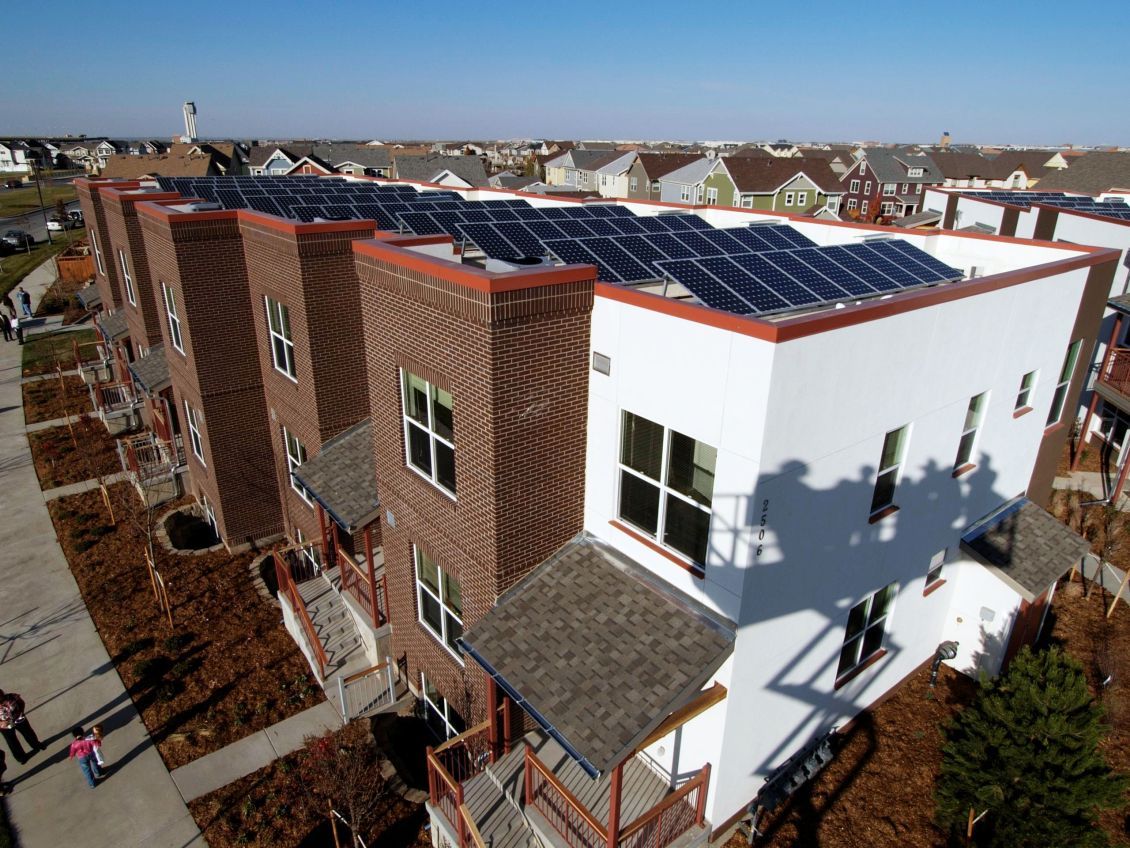Six months after the passage of the Inflation Reduction Act, efforts are underway to ensure that affordable multifamily housing will have pathways to benefit from this historic legislation. Enterprise Community Partners and others in affordable housing continue to work to shape the programs authorized by the IRA through public comment submissions, and through tracking updates and new guidance as it becomes available.
The law, which marks one of the most substantive climate actions in U.S. legislative history, provides $369 billion for investments in climate resilience, energy security programs, and efficiency improvements. As the federal government continues to build out plans for these investments, Enterprise has a unique opportunity to advance long-held priorities, including the equitable creation and preservation of sustainable affordable housing.
“We encourage our partners working to expand and improve affordable housing to continue to weigh in to federal and state agencies with recommendations on how to best ensure these dollars flow effectively and efficiently to benefit low-income communities,” said Krista Egger, vice president of Building Resilient Futures at Enterprise. “With collective input, we’ll see the full potential to ensure communities are ready to face the challenges and opportunities of our changing climate.”
While our October 2022 webinar (view the recording and the related slides) with Novogradac on the IRA is still relevant today for those looking for an introduction to how funds will be allocated, many of the agencies have since released programmatic updates.
The Treasury Department Releases New Guideline on Credits
The Internal Revenue Service, the U.S. Department of Treasury, and the Department of Energy recently released new information on key provisions of the Inflation Reduction Act intended to incentivize investment in underserved communities. The IRS issued a notice that establishes the Low-Income Communities Bonus Credit program, which will provide a boost of up to 20 percentage points to the investment tax credit for solar and wind energy projects in low-income communities.
The IRS notice defines qualified projects as eligible clean energy facilities that generate electricity solely from wind or solar energy and are either located in low-income communities or on Tribal land; serving federally subsidized residential buildings, including housing financed by the Housing Credit; or facilities where at least 50% of the financial benefits of the electricity produced go to households with incomes below 200% of the poverty line or below 80% of the area median gross income (AMI).
- 48C: Qualifying Advanced Energy Project Credit. The initial funding round will include $4 billion, with about $1.6 billion reserved for projects in coal communities. The application process will begin on May 31, 2023.
- 48(e): Low-Income Communities Bonus Credit Program. 1.8 GW of capacity will be available in 2023, with the application opening in Q3 2023.
Teams building homes to the Enterprise Green Communities Criteria will also be interested in program guidance related to 45L, updated tax credits available for dwelling units certified to either the ENERGY STAR or Zero Energy Ready Homes program.
Stay tuned for additional guidance this spring from Treasury regarding potential direct pay provisions for organizations without tax burden.
EPA Announces Initial Guidance on Greenhouse Gas Reduction Fund
In February, the U.S. Environmental Protection Agency issued initial guidance on the new Greenhouse Gas Reduction Fund. The EPA will award nearly $27 billion in financial assistance for activities or technologies that reduce or avoid greenhouse gas emissions or help communities do so — and prioritizes projects without other access to financing.
This summer the EPA will begin to distribute grant funding through two competitions: a $20 billion General and Low-Income Assistance Competition, and a $7 billion Zero-Emissions Technology Fund Competition. The competitions will be aligned with President Biden's Justice40 Initiative, which requires that 40% of the overall benefits of certain federal investments go to disadvantaged communities. The initial program design guidance follows a stakeholder engagement effort including the agency’s Request for Information, to which Enterprise submitted comments.
Enterprise’s comments include recommendations that EPA:
- Leverage the extensive network of Community Development Financial Institutions (CDFIs) to ensure rapid, equitable investment in rural and urban communities across the country.
- Consider the governance structures, reporting requirements, and audit requirements utilized by the CDFI Fund,
- Use existing federal practices to target resources to low-income and disadvantaged communities and for program administration and include equity principles in all GHGRF program design features.
Stay tuned for EPA-hosted Community Roundtables, which will be held this spring as the agency prepares their funding notices.
EPA Seeks Input on Environmental and Climate Justice Program
The EPA will host an informational webinar on Friday, March 10, 2023, from 2:00-3:00 PM ET for community-based organizations, environmental justice organizations, environmental justice advocates, and community leaders.
The agency is accepting feedback through an RFI until March 17 on its $3 billion Environmental and Climate Justice program. The agency is particularly seeking input on competition design, community engagement, equitable distribution of financial resources, grantee eligibility, and technical assistance. Please weigh in!
HUD's New Green and Resilient Retrofit Program
Enterprise submitted comments last year to Department of Housing and Urban Development on its Request for Information on the Green and Resilient Retrofit Program (GRRP) authorized under the IRA. HUD-assisted multifamily properties will be eligible and program guidelines will likely be made available this summer and then available for five years. The purpose of the new program is to improve energy and water efficiency of eligible affordable housing. HUD is currently crafting the program after recently receiving public input on the program’s requirements, grant allocation, and evaluation.
Enterprise’s comments include recommendations that HUD:
- Provide a comprehensive audit tool to enable grantees to determine the best retrofit strategies for their properties and require a comprehensive evaluation approach to ensure that funded retrofits will address multiple aspects of building upgrades.
- Structure financing vehicles for the GRRP to bridge the cost gap between standard construction and the incremental investment that may be needed to build to above-code green and resilient standards and deploy funds for resilient retrofits in low- and moderate-income communities that do not have building codes that provide resilient construction.
For more information, read our full list of recommendations and check out the kickoff webinar for our California Preservation Academy.
Department of Energy Prepares Programs
The Department of Energy recently solicited feedback on how to design its $4.3 billion HOMES program and $4.5 billion for High Efficiency Electric Home Rebate Act through an RFI. Enterprise, along with over 45 partners, signed onto a feedback letter led by the National Housing Trust. DOE has also released state and tribal allocations, detailing how the $9 billion will be allocated. We expect DOE to share program design guidance with states and tribes this spring/summer and for those entities to design their programs this coming fall/winter in response. Rebates are not expected to become available until late 2023 or early 2024.
In the meantime, Enterprise strongly recommends that those in the affordable housing sector establish and strengthen relationships with their state energy office now, to help ensure that as these energy offices are considering how to allocate the funding they expect to receive, housing considerations are front and center.
DOE’s Building Upgrade Prize (Buildings UP) is available to support innovative projects in this space. Join an upcoming webinar to learn more.
We look forward to working with all of you to ensure the programs laid out here help make homes and communities more sustainable, more affordable, and climate resilient for the future. Stay tuned for our next webinar as program details become available.


